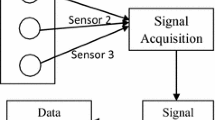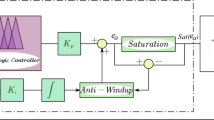Abstract
Accurate parameter estimation in presence of stochastic noise is the essential part of almost all control hardware of the plants. However, the optimal design of the control hardware depends on processing power and installed memory. The proposed research investigation focuses on precise parameter estimation from compressed temporal data of error dynamics with exiguous susceptibility to the robot’s controllability. Instead of using Maximum Likelihood estimation (MLE) and Least Squares (LS) estimation in the time domain, the proposed method exploits the recursive wavelet domain’s properties to selectively store the error data coefficients negating the data related to noise. As a result, data compression is achieved. The proposed algorithm may be directly implemented on any scalable “Very Large Scale Integration” (VLSI) circuit due to the recursive implementation. For the evaluation of robustness, dynamic parameter variation is considered. The variation in scalar & vector-valued error is considered to evaluate the performance of the stochastic system. The proposed algorithm implementation is demonstrated experimentally on commercially available Omni Bundle robot.














Similar content being viewed by others
References
Martin, M.O., Swevers, J., Verdonck, W.: Maximum likelihood identification of a dynamic robot model: implementation issues. Int. J. Robot. Res. 21(2), 89–96 (2002). https://doi.org/10.1177/027836402760475379
Rana, R., Gaur, P., Agarwal, V., Parthasarathy, H.: Tremor estimation and removal in robot-assisted surgery using lie groups and EKF. Robotica 37(11), 1904–1921 (2019)
Lelewer, D.A., Hirschberg, D.S.: Data compression. ACM Comput. Surveys 19(3), 261–296 (1987)
Li, Q., Jianming, H., Yi, Z.: A flow volumes data compression approach for traffic network based on principal component analysis, in Proc. IEEE Intell. Transp. Syst. Conf. (ITSC), Sep./Oct. 2007, pp. 125–130
Li, L., Su, X., Zhang, Y., Hu, J., Li, Z.: Traffic prediction, data compression, abnormal data detection and missing data imputation: An integrated study based on the decomposition of traffic time series, in Proc. IEEE 17th Int. Conf. Intell. Transp. Syst. (ITSC), Oct. 2014, pp. 282–289
Guitton, A., Skordylis, A., Trigoni, N.: Utilizing correlations to compress time-series in traffic monitoring sensor networks, in Proc. IEEE Wireless Commun. Netw. Conf. (WCNC), Mar. (2007), pp. 2479–2483
Skordylis, A., Guitton, A., Trigoni, N.: Correlation-based data dissemination in traffic monitoring sensor networks, in Proc. ACM CoNEXT Conf., 2006, p. 42
Srisooksai, T., Keamarungsi, K., Lamsrichan, P., Araki, K.: Practical data compression in wireless sensor networks: a survey. J. Netw. Comput. Appl. 35(1), 37–59 (2012)
Klimenko, S., Mitselmakher, G., Sazonov, A.: Losless compression of LIGO data, California Inst. Technol., Pasadena, and Massachusetts Inst. Technol., Cambridge, MA, USA, Tech. Note LIGO-T000076-00-D (2000)
Misiti, M., Misiti, Y., Oppenheim, G., Poggi, J.-M.: Wavelet Toolbox User’s Guide. MathWorks, Natick, MA, USA (1996)
Ding, J., Zhang, Z., Ma, X.: A method for urban traffic data compression based on wavelet-PCA, in Proc. 4th Int. Joint Conf. Comput. Sci. Optim. (CSO), Apr. 2011, pp. 1030–1034
Qiao, F., Liu, H., Yu, L.: Incorporating wavelet decomposition technique to compress TransGuide intelligent transportation system data. Transp. Res. Rec. J. Transp. Res. Board 1968(1), 63–74 (2006)
Xiao, Y., Xie, Y.-M., Lu, L., Gao, S.: The traffic data compression and decompression for intelligent traffic systems based on two-dimensional wavelet transformation, in Proc. 7th Int. Conf. Signal Process. (ICSP), vol. 3. Aug./Sep. 2004, pp. 2560–2563
Agarwal, S., Regentova, E.E., Kachroo, P., Verma, H.: Multidimensional compression of ITS data using wavelet-based compression techniques. IEEE Trans. Intell. Transp. Syst. 18(7), 1907–1917 (2017). https://doi.org/10.1109/TITS.2016.2613982
Ku, C.T., Hung, K.C., Wu, T.C., Wang, H.S.: Wavelet-based ECG data compression system with linear quality control scheme. IEEE Trans. Biomed. Eng. 57(6), 1399–1409 (2010). https://doi.org/10.1109/TBME.2009.2037605
Salomon, D.: Data Compression: The Complete Reference. Springer, New York, NY, USA (2004)
Chui, C.K.: An Introduction to Wavelets, vol. 1. Academic, San Francisco, CA, USA (1992)
Adeli, H., Karim, A.: Wavelets in Intelligent Transportation Systems. Wiley, Hoboken, NJ, USA (2005)
Lin, C.M., Boldbaatar, E.A.: Fault accommodation control for a biped robot using a recurrent wavelet Elman neural network. IEEE Syst. J. 11(4), 2882–2893 (2017). https://doi.org/10.1109/JSYST.2015.2409888
Moreno-Valenzuela J., Aguilar-Avelar C.: Identification of underactuated mechanical systems. In: Motion Control of Underactuated Mechanical Systems. Intelligent Systems, Control and Automation: Science and Engineering, vol 88. Springer (2018)
Yen, V.T., Nan, W.Y., Van Cuong, P., et al.: Int. J. Control Autom. Syst. 15, 2930 (2017). https://doi.org/10.1007/s12555-016-0371-5
Rana, R., Agarwal, V., Parthasarthy, H.: Wavelet transformation based tremor removal. In: 2015 International Conference on Computer, Communication and Control (IC4), 2015, pp. 1–3. https://doi.org/10.1109/IC4.2015.7375544
Yang, C., Jiang, Y., He, W., Na, J., Li, Z., Xu, B.: Adaptive parameter estimation and control design for robot manipulators with finite-time convergence. IEEE Trans. Ind. Electr. 65(10), 8112–8123 (2018). https://doi.org/10.1109/TIE.2018.2803773
Kuang, W.T., Morris, A.S.: Using short-time Fourier transform and wavelet packet filter banks for improved frequency measurement in a Doppler robot tracking system. IEEE Trans. Instrum. Meas. 51(3), 440–444 (2002). https://doi.org/10.1109/TIM.2002.1017713
Sharma, Manish, Verma, Ajay: Wavelet reduced order observer based adaptive tracking control for a class of uncertain multiple time delay nonlinear systems subjected to actuator saturation using actor critic architecture. Proc. Eng. 38, 1297–1308 (2012). https://doi.org/10.1016/j.proeng.2012.06.160. (ISSN 1877-7058,)
Oweiss, K.G., Mason, A., Suhail, Y., Kamboh, A.M., Thomson, K.E.: A scalable wavelet transform VLSI architecture for real-time signal processing in high-density intra-cortical implants. IEEE Trans. Circ. Syst. I Regul. Pap. 54(6), 1266–1278 (2007). https://doi.org/10.1109/TCSI.2007.897726
Singla, R., Parthasarathy, H., Agarwal, V., et al.: Nonlinear Dyn 86, 559 (2016). https://doi.org/10.1007/s11071-016-2908-9
Rana, R., Agarwal, V., Gaur, P., Parthasarathy, H.: Design of optimal UKF state observer-controller for stochastic dynamical systems. IEEE Trans. Ind. Appl. (2020). https://doi.org/10.1109/TIA.2020.3048647
Frazier, Michael W.: An Introduction to Wavelets Through Linear Algebra. Springer-Verlag, New York (2006)
Mendel, Jerry M.: Lessons in Estimation Theory for Signal Processing, Communications, and Control, 2nd edn. Pearson, London (1995)
Wilson, A.D., Schultz, J.A., Murphey, T.D.: Trajectory synthesis for fisher information maximization. IEEE Trans. Robot. 30(6), 1358–1370 (2014). https://doi.org/10.1109/TRO.2014.2345918
Jia, J., Zhang, M., Li, C., et al.: Improved dynamic parameter identification method relying on proprioception for manipulators. Nonlinear Dyn. 105, 1373–1388 (2021). https://doi.org/10.1007/s11071-021-06612-y
Zhang, S., Wang, S., Jing, F., et al.: Parameter estimation survey for multi-joint robot dynamic calibration case study. Sci. China Inf. Sci. 62, 202203 (2019). https://doi.org/10.1007/s11432-018-9726-3
Olsen, M.M., Petersen, H.G.: A new method for estimating parameters of a dynamic robot model. IEEE Trans. Robot. Autom. 17(1), 95–100 (2001). https://doi.org/10.1109/70.917088
Liu, G., Li, Q., Fang, L., Han, B., Zhang, H.: A new joint friction model for parameter identification and sensor-less hand guiding in industrial robots. Ind. Robot 47(6), 847–857 (2020)
Poignet, P., Gautier, M.: Comparison of weighted least squares and extended Kalman filtering methods for dynamic identification of robots. In: Proceedings 2000 ICRA. Millennium Conference. IEEE International Conference on Robotics and Automation. Symposia Proceedings (Cat. No.00CH37065), 2000, vol. 4, pp. 3622–3627. https://doi.org/10.1109/ROBOT.2000.845296
Author information
Authors and Affiliations
Ethics declarations
Conflict of interest
The authors declare that they have no conflict of interest.
Availability of data and material
All related data is available in the manuscript. However, the data will be made available upon request.
Additional information
Publisher's Note
Springer Nature remains neutral with regard to jurisdictional claims in published maps and institutional affiliations.
Appendix A Recursive implementation
Appendix A Recursive implementation
To compare the RLS in time domain with RLS in wavelet domain we first recast our model as follows: The model (31) that relates measurement data to parameters can be cast in following general form
where we denote \(\delta \theta \) by \(\theta \), \(\alpha _t+K_d\beta _t+K_p\rho _t\) by \(\xi (t)\), \(\Gamma _t\) by H(t) and W(t) is the noise. In the time domain, the LS estimate of \(\theta \) based on temporal data upto time T is
which is easily cast in time recursive form by using the relations
and making use of the matrix inversion lemma [30]. On the other hand, if the same is attempted using the WT, by defining
then the model will be
and our LS algorithm would be
which can also be cast in time recursive form using
The reduction in the complexity using the WT method is apparent once we note that the number of wavelet indices (n, k) is much smaller than the total number of time samples. It should be noted that if the noise is not Gaussian white, then the ML algorithm in the time domain is not recursively implementable and of course not also recursively implementable in wavelet domain. In such a case, both ML in the time domain and ML in the wavelet domain must be implemented using a block processing approach and since we are using fewer wavelet coefficients then time samples, the wavelet based ML approach is far superior then time domain based ML approach. Specifically consider the model from Eq. (101) with W(t) as non-Gaussian white. Then, the ML estimate is given by
and we have to solve the following, which is not implementable recursively
Now for the Wavelet domain we can write Eq. (10) as
and the ML estimate is given by
Equation (115) is not implementable recursively.
Rights and permissions
About this article
Cite this article
Rana, R., Gaur, P., Agarwal, V. et al. Parameter estimation, data compression and stochastic noise elimination in robotics: a wavelet domain-based integrated approach. Nonlinear Dyn 107, 2633–2655 (2022). https://doi.org/10.1007/s11071-021-07141-4
Received:
Accepted:
Published:
Issue Date:
DOI: https://doi.org/10.1007/s11071-021-07141-4




